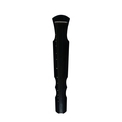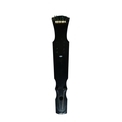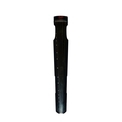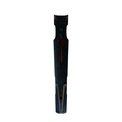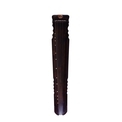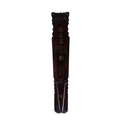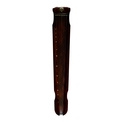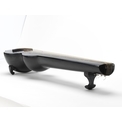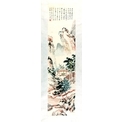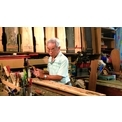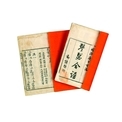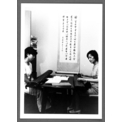Tools used in the ninth step of qin making process
Tools used in the ninth step of qin making process – stringing:(1) Large tone tester – for testing all seven strings. Place the qin on top to test it.
(2) Small tone tester – fasten one string onto it, and affix the string onto the bridge and the tail of the qin to perform the acoustic test. Can be used to test a specific string position if needed.
(3) Tuning pegs and tuning tassels of the qin – if results of the acoustic testing are positive, the tuning pegs and the tuning tassels can be used to mount the strings onto the instrument.

| Date | 2013 |
| Material Type | Image |
| Collection | The Legend of Silk and Wood: A Hong Kong Qin Story |
| Source | Intangible Cultural Heritage Office and Hong Kong Heritage Museum |
| Repository | Intangible Cultural Heritage Office |
| Note to Copyright | Permission for use in Hong Kong Memory is given by Intangible Cultural Heritage Office and Hong Kong Heritage Museum |
| Accession No. | lcs-hkqs-0125 |
Tools used in the ninth step of qin making process
Tools used in the ninth step of qin making process – stringing:(1) Large tone tester – for testing all seven strings. Place the qin on top to test it.
(2) Small tone tester – fasten one string onto it, and affix the string onto the bridge and the tail of the qin to perform the acoustic test. Can be used to test a specific string position if needed.
(3) Tuning pegs and tuning tassels of the qin – if results of the acoustic testing are positive, the tuning pegs and the tuning tassels can be used to mount the strings onto the instrument.

| Date | 2013 |
| Material Type | Image |
| Collection | The Legend of Silk and Wood: A Hong Kong Qin Story |
| Source | Intangible Cultural Heritage Office and Hong Kong Heritage Museum |
| Repository | Intangible Cultural Heritage Office |
| Note to Copyright | Permission for use in Hong Kong Memory is given by Intangible Cultural Heritage Office and Hong Kong Heritage Museum |
| Accession No. | lcs-hkqs-0125 |
Tools used in the ninth step of qin making process
Tools used in the ninth step of qin making process – stringing:(1) Large tone tester – for testing all seven strings. Place the qin on top to test it.
(2) Small tone tester – fasten one string onto it, and affix the string onto the bridge and the tail of the qin to perform the acoustic test. Can be used to test a specific string position if needed.
(3) Tuning pegs and tuning tassels of the qin – if results of the acoustic testing are positive, the tuning pegs and the tuning tassels can be used to mount the strings onto the instrument.

| Date | 2013 |
| Material Type | Image |
| Collection | The Legend of Silk and Wood: A Hong Kong Qin Story |
| Source | Intangible Cultural Heritage Office and Hong Kong Heritage Museum |
| Repository | Intangible Cultural Heritage Office |
| Note to Copyright | Permission for use in Hong Kong Memory is given by Intangible Cultural Heritage Office and Hong Kong Heritage Museum |
| Accession No. | lcs-hkqs-0125 |
Tools used in the ninth step of qin making process
Tools used in the ninth step of qin making process – stringing:(1) Large tone tester – for testing all seven strings. Place the qin on top to test it.
(2) Small tone tester – fasten one string onto it, and affix the string onto the bridge and the tail of the qin to perform the acoustic test. Can be used to test a specific string position if needed.
(3) Tuning pegs and tuning tassels of the qin – if results of the acoustic testing are positive, the tuning pegs and the tuning tassels can be used to mount the strings onto the instrument.

| Date | 2013 |
| Material Type | Image |
| Collection | The Legend of Silk and Wood: A Hong Kong Qin Story |
| Source | Intangible Cultural Heritage Office and Hong Kong Heritage Museum |
| Repository | Intangible Cultural Heritage Office |
| Note to Copyright | Permission for use in Hong Kong Memory is given by Intangible Cultural Heritage Office and Hong Kong Heritage Museum |
| Accession No. | lcs-hkqs-0125 |
Tools used in the ninth step of qin making process
Tools used in the ninth step of qin making process – stringing:(1) Large tone tester – for testing all seven strings. Place the qin on top to test it.
(2) Small tone tester – fasten one string onto it, and affix the string onto the bridge and the tail of the qin to perform the acoustic test. Can be used to test a specific string position if needed.
(3) Tuning pegs and tuning tassels of the qin – if results of the acoustic testing are positive, the tuning pegs and the tuning tassels can be used to mount the strings onto the instrument.

| Date | 2013 |
| Material Type | Image |
| Collection | The Legend of Silk and Wood: A Hong Kong Qin Story |
| Source | Intangible Cultural Heritage Office and Hong Kong Heritage Museum |
| Repository | Intangible Cultural Heritage Office |
| Note to Copyright | Permission for use in Hong Kong Memory is given by Intangible Cultural Heritage Office and Hong Kong Heritage Museum |
| Accession No. | lcs-hkqs-0125 |
Tools used in the ninth step of qin making process
Tools used in the ninth step of qin making process – stringing:(1) Large tone tester – for testing all seven strings. Place the qin on top to test it.
(2) Small tone tester – fasten one string onto it, and affix the string onto the bridge and the tail of the qin to perform the acoustic test. Can be used to test a specific string position if needed.
(3) Tuning pegs and tuning tassels of the qin – if results of the acoustic testing are positive, the tuning pegs and the tuning tassels can be used to mount the strings onto the instrument.

| Date | 2013 |
| Material Type | Image |
| Collection | The Legend of Silk and Wood: A Hong Kong Qin Story |
| Source | Intangible Cultural Heritage Office and Hong Kong Heritage Museum |
| Repository | Intangible Cultural Heritage Office |
| Note to Copyright | Permission for use in Hong Kong Memory is given by Intangible Cultural Heritage Office and Hong Kong Heritage Museum |
| Accession No. | lcs-hkqs-0125 |
Tools used in the ninth step of qin making process
Tools used in the ninth step of qin making process – stringing:(1) Large tone tester – for testing all seven strings. Place the qin on top to test it.
(2) Small tone tester – fasten one string onto it, and affix the string onto the bridge and the tail of the qin to perform the acoustic test. Can be used to test a specific string position if needed.
(3) Tuning pegs and tuning tassels of the qin – if results of the acoustic testing are positive, the tuning pegs and the tuning tassels can be used to mount the strings onto the instrument.

| Date | 2013 |
| Material Type | Image |
| Collection | The Legend of Silk and Wood: A Hong Kong Qin Story |
| Source | Intangible Cultural Heritage Office and Hong Kong Heritage Museum |
| Repository | Intangible Cultural Heritage Office |
| Note to Copyright | Permission for use in Hong Kong Memory is given by Intangible Cultural Heritage Office and Hong Kong Heritage Museum |
| Accession No. | lcs-hkqs-0125 |
Tools used in the ninth step of qin making process
Tools used in the ninth step of qin making process – stringing:(1) Large tone tester – for testing all seven strings. Place the qin on top to test it.
(2) Small tone tester – fasten one string onto it, and affix the string onto the bridge and the tail of the qin to perform the acoustic test. Can be used to test a specific string position if needed.
(3) Tuning pegs and tuning tassels of the qin – if results of the acoustic testing are positive, the tuning pegs and the tuning tassels can be used to mount the strings onto the instrument.

| Date of Death | 2013 |
| Material Type | Image |
| Collection | The Legend of Silk and Wood: A Hong Kong Qin Story |
| Source | Intangible Cultural Heritage Office and Hong Kong Heritage Museum |
| Repository | Intangible Cultural Heritage Office |
| Note to Copyright | Permission for use in Hong Kong Memory is given by Intangible Cultural Heritage Office and Hong Kong Heritage Museum |
| Accession No. | lcs-hkqs-0125 |
Tools used in the ninth step of qin making process
Tools used in the ninth step of qin making process – stringing:(1) Large tone tester – for testing all seven strings. Place the qin on top to test it.
(2) Small tone tester – fasten one string onto it, and affix the string onto the bridge and the tail of the qin to perform the acoustic test. Can be used to test a specific string position if needed.
(3) Tuning pegs and tuning tassels of the qin – if results of the acoustic testing are positive, the tuning pegs and the tuning tassels can be used to mount the strings onto the instrument.

| Date | 2013 |
| Material Type | Image |
| Collection | The Legend of Silk and Wood: A Hong Kong Qin Story |
| Source | Intangible Cultural Heritage Office and Hong Kong Heritage Museum |
| Note to Copyright | Permission for use in Hong Kong Memory is given by Intangible Cultural Heritage Office and Hong Kong Heritage Museum |
| Accession No. | lcs-hkqs-0125 |
Tools used in the ninth step of qin making process
Tools used in the ninth step of qin making process – stringing:(1) Large tone tester – for testing all seven strings. Place the qin on top to test it.
(2) Small tone tester – fasten one string onto it, and affix the string onto the bridge and the tail of the qin to perform the acoustic test. Can be used to test a specific string position if needed.
(3) Tuning pegs and tuning tassels of the qin – if results of the acoustic testing are positive, the tuning pegs and the tuning tassels can be used to mount the strings onto the instrument.

| Date | 2013 |
| Material Type | Image |
| Collection | The Legend of Silk and Wood: A Hong Kong Qin Story |
| Source | Intangible Cultural Heritage Office and Hong Kong Heritage Museum |
| Repository | Intangible Cultural Heritage Office |
| Note to Copyright | Permission for use in Hong Kong Memory is given by Intangible Cultural Heritage Office and Hong Kong Heritage Museum |
| Accession No. | lcs-hkqs-0125 |
Copyright © 2012 Hong Kong Memory


